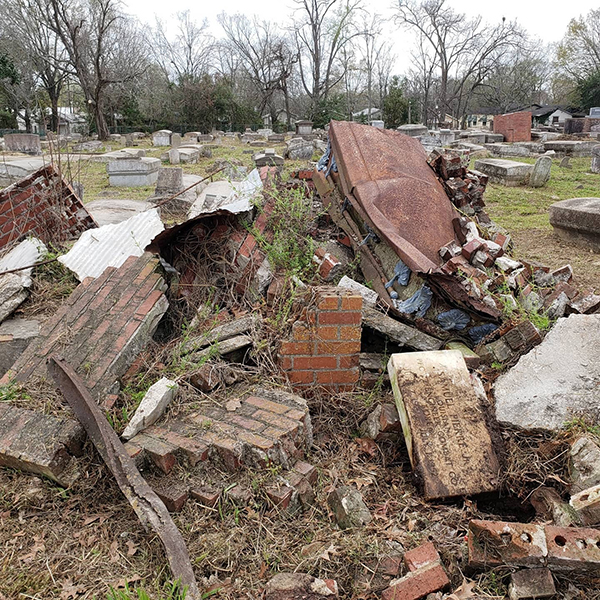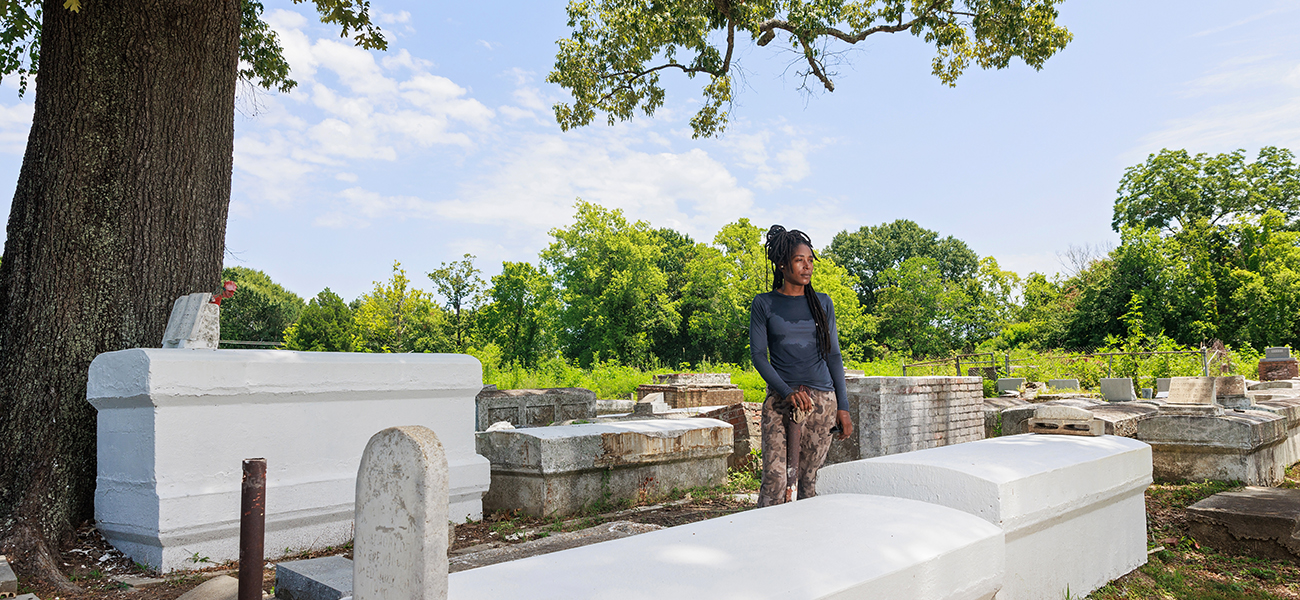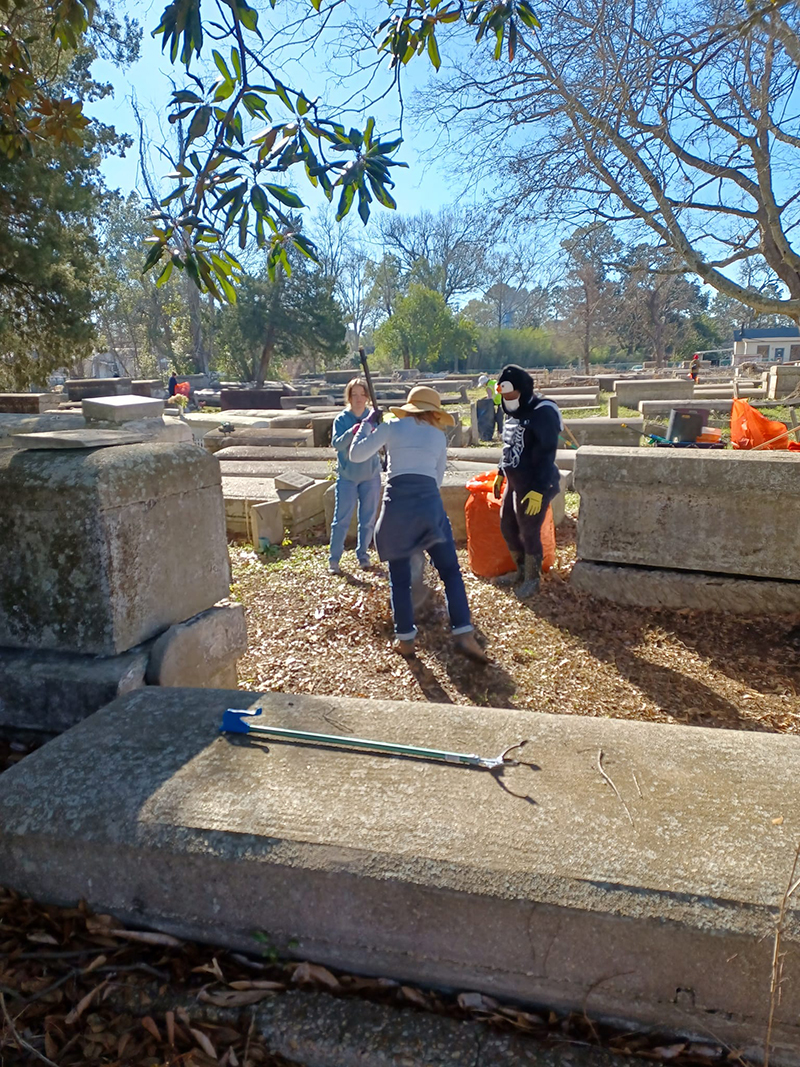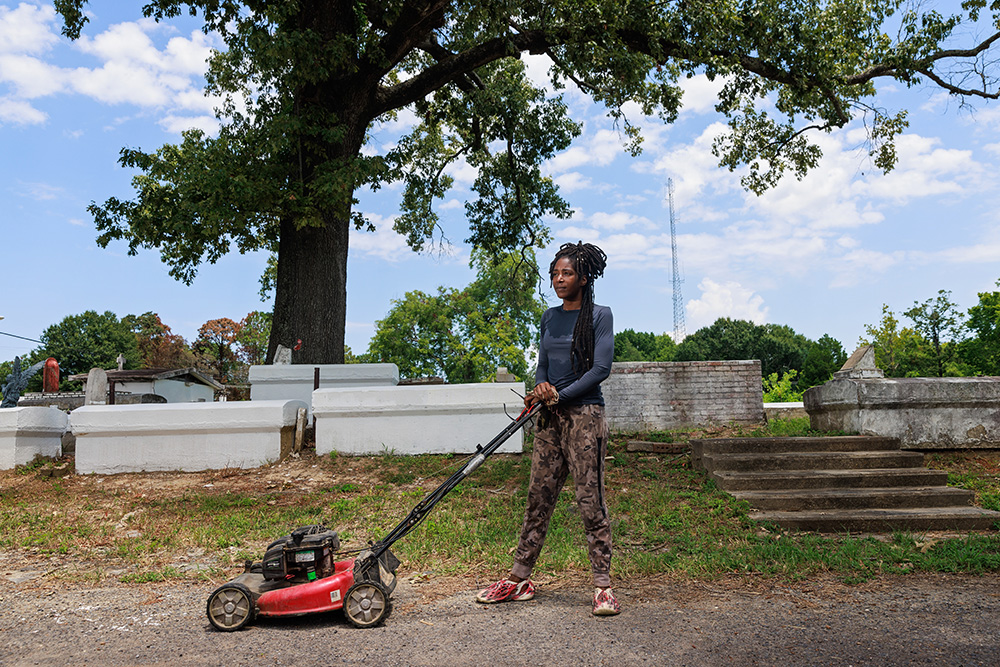One morning in the summer of 2018, Markeda Cottonham and her then-7-year-old daughter struck out on foot for church, traveling from their home in the Fairfields neighborhood to the Kingdom Hall on South 22nd Street. The two liked walking, even in hot, car-centric Baton Rouge.
That’s when they noticed Sweet Olive Cemetery: the oldest Black cemetery within the city limits.
“I’ve always been drawn to historical places,” says Cottonham, who had moved that year from San Francisco to Baton Rouge, her family’s ancestral home. “Growing up, my grandmother always took us to cemeteries to honor the dead. I wanted to take my daughter there to show her how loved ones are memorialized.”
|
|
|
But when the two later sidelined into Sweet Olive, it didn’t take long to notice what locals had seen for decades. The place was in serious decline.
Ownership of the cemetery has been murky over the years, with no single entity ever really taking responsibility for its upkeep. As a result, high grass, vines and weeds snake along tight pathways between the graves, tilting stones unnaturally with slow, creeping force.
That day, Cottonham’s daughter spotted an above-ground mausoleum thats surface had a gaping hole. She peered in and saw exposed human remains. One gravesite had crumbled so badly, the casket within was fully visible.
Cottonham found it intolerable. In the coming months, she began poking around to find out why the historic cemetery had been allowed to deteriorate.
The answer was more complicated than she could have imagined—though a solution could now be on the horizon.
Decades of decline
Pass by Sweet Olive on the occasional Saturday, and it’s not unusual to see volunteers in long pants and shirts picking up trash or mowing grass. Many Baton Rouge residents have family members buried at Sweet Olive. Others drive past it routinely. But with no one formally responsible for the cemetery, its care has been largely driven by a series of nonprofits and community volunteers.
The approximately 5-acre parcel in Mid City holds about 5,000 interments, which date back officially to 1898. Historians speculate they could have begun much earlier and likely include former slaves.
The first documented owners were two Black benevolent societies, according to historian Anne Mahoney. Now the curator of Capitol Park Museum, Mahoney researched the cemetery for a master’s thesis between 2012 and 2014.
But those societies have long since been dissolved, and while it’s possible that two local churches related to them are the cemetery’s current owners, neither has taken responsibility for its perpetual care.
A flurry of maintenance projects took place in the mid-1970s, thanks to the 1975 establishment of the nonprofit Sweet Olive Cemetery Association, which brought federal funding to build the brick and steel fence on the cemetery’s periphery. But though the organization still exists, it’s essentially been defunct since 2001, even as stones crumble and vegetation runs amok.
In 2020, Cottonham took matters into her own hands. She began organizing regular cleanups and, a year later, incorporated the nonprofit Friends of Sweet Olive Cemetery. The organization is now raising funds to restore gravesites through an adopt-a-grave initiative launched this spring.
The historic confusion over who should take care of Sweet Olive has also prompted the Mid City Redevelopment Alliance to step into the breach and facilitate cleanups. The nonprofit has no authority over Sweet Olive, its executive director Kismet Gray is quick to say, but it provides service organizations with basic information and lawn equipment. Clean ups happen once a month on average—not nearly enough to keep pace.
Gray says MCRA has tried to stay out of the ownership question, focusing instead on helping volunteers.
“I want to honor those persons’ ancestors who are there, because they deserve it,” Gray says. “The intricacies of it, well, it’s just been a journey. … We’re just trying to make sure that maintenance is put in place in the meantime until all that gets sorted out.”
And it could be sorted out sooner than later. Last September, Cottonham, Fairleigh Jackson of Preserve Louisiana and other stakeholders pushed a moonshot idea that the City of Baton Rouge assume ownership of the cemetery and assign its upkeep to BREC. Just a few blocks away, BREC takes care of predominantly white Magnolia Cemetery, which is on the National Register of Historic Places and was a significant site in the Battle of Baton Rouge. That arrangement has been in place since 1947—when the country was firmly in the grip of Jim Crow laws.
But when the group asked about the city taking responsibility for the cemetery, Cottonham was told in an email that the city could not “provide an answer at this time.”
Then in November, Cottonham, Jackson, Gray, the NAACP and others requested a meeting with Mayor Sharon Weston Broome’s office to further discuss Sweet Olive. While that particular meeting never happened, their requests may have helped get the ball rolling.
 A rocky road to resolution
A rocky road to resolution
Sweet Olive’s future is now being discussed in earnest, according to Broome’s spokesperson Mark Armstrong. The Parish Attorney’s office, he says, recently determined that two churches, Mount Zion Baptist Church and Mount Pleasant Baptist Church, are the cemetery’s current owners. Armstrong says that Councilwoman Carolyn Coleman has been working with the two churches about the issue since the spring.
A meeting took place in early August between the Mayor’s Office, BREC, the Baton Rouge Area Chamber, the Parish Attorney’s Office and Coleman about the city assuming ownership of the cemetery with the churches’ permission, according to Armstrong. Coleman’s office did not return calls for comment.
“We are in a very strong position to move forward with a long-term plan for maintaining Sweet Olive Cemetery,” Armstrong says.
Neither a timeline nor further details were announced, however. And according to BREC Director of Communications Cheryl Michelet, the early August meeting was simply a brainstorming session.
Moreover, any resolution is likely easier said than done. One of the biggest problems with blighted properties in Baton Rouge, not just Sweet Olive, is the difficulty in determining who has inherited them. It’s why so many abandoned properties whose original owners have died and descendants have scattered now sit in limbo.
But, if the city were to clear the bureaucratic hoops necessary to assume ownership in the Sweet Olive case, its maintenance would automatically fall to BREC. This is due to an existing ordinance that says cemeteries owned by the City-Parish are maintained by the parks systems, Michelet says.
The question then becomes: How would BREC fund Sweet Olive’s maintenance? The parks system doesn’t have an official figure, Michelet says, but it estimates Sweet Olive’s initial rehabilitation will cost around $500,000. Another $40,000 would be required annually for grass cutting, a number based on the same amount budgeted for Magnolia Cemetery’s upkeep.
A battle over burials
The cemetery is now also facing two separate legal issues. One concerns the exposed human remains.
Cottonham first reported their existence to local authorities and the media in 2019. When nothing happened, she brought the issue to the Louisiana Attorney General’s office last year. It prompted a lawsuit, which triggered a search by the state (independent of the city’s) for Sweet Olive’s owners.

Assistant Attorney General Ryan Seidemann, an expert in cemetery law working on the Sweet Olive case, says the state has the authority to recover and secure human remains that are at risk of theft or damage. The situation isn’t uncommon in old cemeteries, but it’s easier to resolve when there’s an obvious owner or operator.
“Sweet Olive is more difficult,” says Seidemann, also chair of the state’s Cemetery Response Task Force. “There’s no authorized operator, so there isn’t anybody for us to contact.”
In their search the state found that Sweet Olive was, at some point, deeded to three entities, one of which is Mount Zion Baptist Church, he says.
The ownership of the other two portions of the cemetery isn’t clear, Seidemann says. According to the state’s research, one fragment was deeded to two women in the early part of the 20th century whose descendants have not been identified. The other was deeded to a church benevolent society that has not been definitively connected to a current entity.
Mount Zion has been named as the sole defendant in the lawsuit to recover the human remains because it is located on the parcel determined to be owned by the church. Seidemann says it’s been difficult to get Mount Zion to communicate. The church did not respond to 225 for comment.
Other troubles remain for Sweet Olive, including a parallel investigation by the Louisiana Cemetery Board into recent unpermitted burials. Since the early 2000s, the cemetery has lacked a permit for new burials, but one took place in February 2022, says Seidemann, who could not comment further because the investigation is ongoing.
What does the future hold?
Cottonham, who now lives an hour away in Carencro, says that while her group hasn’t been informed by the city about recent talks, she’s thrilled about the possibility of the city taking over Sweet Olive.
“If that’s true, that’s awesome,” she says.“That’s the goal. That would be beautiful.”
She’s tempering her excitement with caution, though, given the slow pace of progress.
In the meantime, she’ll hold on to a dream of Sweet Olive becoming a sanctuary for visitors and family members, and an important thread in the tapestry of neglected Black burial grounds.
She pictures cemetery tours and educational programs, the kind she would have liked for her daughter to experience back on that first walk-through in 2018.
But for now, Cottonham will continue to do what volunteers have done for decades: roll up her sleeves, pull out her lawn mower and get to work.
Read more about Sweet Olive Cemetery’s history
As part of a 2014 master’s thesis at the University of Louisiana at Lafayette, historian Anne Mahoney spent two years conducting significant research on Sweet Olive Cemetery, poring over local obituaries, historic maps and other documents to stitch together a compelling timeline and history of the cemetery. Read Mahoney’s digitized thesis and see some of the Sweet Olive graves at sweet olive cemetery. weebly.comsweetolivecemetery.weebly.com.
 Why isn’t Sweet Olive on the National Register of Historic Places?
Why isn’t Sweet Olive on the National Register of Historic Places?
The nomination process for adding the cemetery to the register was started by historian Anne Mahoney in 2014. New Orleans historic preservation firm Row 10 also donated work toward the nomination. But preservation officials at the state told Mahoney the nomination needs a lengthy context survey assessing other historic Black cemeteries in the region before it can move forward, she says.
While it seems a no-brainer the city’s oldest African American cemetery would eventually make it to the register, some say such a designation might not do much for future maintenance. “The sad thing about National Register listings is they’re pretty much an honorarium,” says Preserve Louisiana’s Fairleigh Jackson. “Although it could make the cemetery eligible for various grants. But who’s going to do that? It should be the owners.”
 Are there other government orgs that could help Sweet Olive?
Are there other government orgs that could help Sweet Olive?
In 2018, the Louisiana Legislature passed a bill creating the 30-member Slavery Ancestral Burial Grounds Preservation Commission to “study and develop measures to preserve and protect unmarked and historic burial grounds, graves and cemeteries of the formerly enslaved in Louisiana.” The commission falls under the purview of the Department of Culture, Recreation and Tourism. Theoretically, this group could have sway in bringing attention and improvements to Sweet Olive, since the cemetery likely holds former slaves. But in its five year history, it has met only once.
“I emailed about it so many times,” says Fairleigh Jackson, who represents the NAACP on the commission. “The excuse that I was given was that (the committee is) too large to have a quorum.”
|
|
|
DCRT Assistant Secretary Kristin Sanders says “a number of factors” have thwarted the committee’s ability to meet, including the availability of its co-chairs, the difficulty in ensuring a quorum and the pandemic.
“Currently, we are making efforts to reach out to the nominating organizations to fill the remaining vacant positions and update existing appointments,” Sanders says. “We plan to schedule a meeting in the coming months.”
This article was originally published in the September 2023 issue of 225 magazine.








